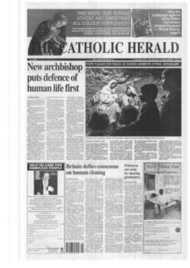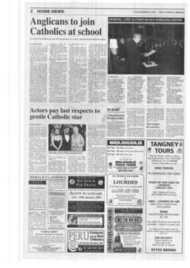Page 5, 7th December 2001
Page 5

Report an error
Noticed an error on this page?If you've noticed an error in this article please click here to report it.
Tags
Share
Related articles
The Truth About Harry Potter
Lay Off Harry Potter
Jumping •
Did Vatican Ii Usher In Our Secular Age?
By Christina White
;iit pou twill) Want to &Mk in the
occult, 5teer dear of 3ljarrp Votter....
The Harry Potter books have nothing to do with New Age spirituality or the occult, says Moyra Doorly
these are fairy-tales which teach us the limitations of mere rationality, and the power of good over evil
4.ivol nved in
avc you ever been
the occult" is one of the questions routinely asked of psychiatric patients, particularly if symptoms are of the hallucinatory and delusional.), variety. Have you ever read and enjoyed fairy-tales isn't, thank goodness. A history of liking fairy-tales does not feature among the standard indicators used to diagnose psychotic illness — which is good news for us Harry Potter fans since fairy-tales are essentially what the stories are.
There are some who claim that the Harry Potter books and film are full of new age spirituality and others who fear that the stories may encourage children, and indeed adults, to dabble in the occult. In attempting to address these issues, there are distinctions to be made.
The first is between the realm of the occult and fairyland. According to CS Lewis in The Discarded Image, it was a darkening of superstition following the accession of James I that led to the inhabitants of fairyland being identified with fallen angels or devils. During the Middle Ages, the faerie folk had been described variously as a third rational species distinct from angels and men; as demoted, but definitely not fallen, angels; as a special class of the dead.
The blurring of this distinction is a modern phenomenon, which isn't to say that human contact with fairyland was ever entirely risk free. It was always important to know and play by the rules and preferable to avoid contact altogether, since the simple human being was all too likely to transgress the fairy codes, albeit unwittingly. The important thing to note is that fairyland is a highly moral place.
In fairyland there's always a hero or heroine, who is usually a child, and always a wicked witch or giant. Helpers appear, magic is employed, a quest is undertaken, the battle is fought and goodness prevails. Courage, loyalty, truth, beauty are the virtues that win the day. This may not be a Christian morality, neither is it the morality of the devils, which Aleister
Crow
ley summed up as "do what thou wilt shall be the whole of the law".
The second distinction is between fairyland and the New Age. One of the central tenets of the New Age movement is that evil doesn't exist and that the devil is a creation of the Church intended to scare people and keep them in line. If New Age morals can be summed up by the wicean suggestion to "do what thou wilt provided it harm none", then Harry Potter is not a New Age tale.
Obligations are put on Harry, sacrifices have been made and must still be made, the battle against evil will be long and hard-fought and the lines on the battlefield are clearly marked. Harry is not in search of enlightenment or personal fulfilment. Something bigger is at stake, something mysterious and greater than him.
Some of the confusion may stem from the fact that Hogwarts is a school of wizardry and witchcraft. Unfortunately there is no female equivalent of the term wizard, the male equivalent of a witch being a warlock, which Harry isn't. And of course there are flying broomsticks, cauldrons, cloaks and pointed hats.
But these are fairy tales, nevertheless, and fairy tales are a form of teaching story. They teach that the supernatural is dangerous and best avoided unless you are possessed of the necessary qualities and knowledge — and even then you'd better be careful. They teach that there is more to life than meets the rationalist's eye. And they teach the importance of the choices we make.
It all rests on the 11-year-old Harry wanting to be a wizard and not a dentist or an airline pilot. It isn't enough that his father was a wizard and his grandfather before that. His life with the super-suburban Dursleys had to be so miserable that it's a wonder Hagrid the giant got to him with the all-important Hogwarts letter before social services did.
Despite the treatment handed out by his foster family, Harry displays none of the behaviour expected of the modern deprived child — like setting fire to telephone boxes, shoplifting, bullying younger children or absconding from school to run with the local gang.
Instead, Harry reacts like children in fairy stories always do when they find themselves in his position. No matter how cruel the step-mother or back-breaking the work they are forced to do, the child in the tale is never bitter or angry or resentful.
His sweet nature and extraordinary gifts mark him out as special and different, much to the fury of those around him. His escape into a world of magic must have struck a chord with many children enduring an excruciating home life. In real life, the therapists and child psychologists would have had a field day analysing Harry's reports of Diagon Alley, the wizards' shopping mall; the Hogwarts Express which leaves Kings Cross from platform 9 3/4; the threeheaded guard dog called Fluffy; and the forbidden forest which is home to centaurs and unicorns.
They might have explained the magic away as wish fulfilment and the fantasy castles and hidden chambers as expressions of repressed desires.
The evil Lord
Volde
mort might have been evidence of paranoid tendencies in Harry, or of his overbearing super-ego.
But, thankfully, the counselling profession didn't get a chance to play its part in dismantling the mystery. The Dursleys could see and hear Hagrid too and it turns out they had known Harry's true identity all along. It wasn't that they didn't believe in magic, rather that they thought magicians were freaks. Harry doesn't need to see a psychiatrist. The only person whose sanity is questioned is Mr Dursley.
It is said that there are no new stories, only new angles. Much has been written about the extent to which 1 K Rowling has borrowed from all parts of the western tradition, from classical literature, Nordic and Celtic mythology, every kind of folklore and Tom Brown's Schooldays. What the incredible popularity of the books suggests is that there may be no decent new stories, only new and varied combinations of old ones.
Of all the old stories, one of the most enduring must be the conflict between good and evil, a story that has been played down somewhat in the modernist age. Good and evil are far too distinct and obviously opposites to sit comfortably in the modernist mind.
Part of the modernist project has been to strip everything down to its essence, to discover the socalled "unity that underlies all things". This has involved disre
gard
ing the distinctions and differences between things because these are considered superficial and superfluous. In the search for "essences", everything merges as the boundaries between things dissolve. Noth ing is absolute because all things are equally valid. The modernist world view is towards the homogeneous, the value-free and the direction-less.
In modernist writing, as in art, architecture and music, appearances are subservient to the "truth" that lies beneath the surface. The meaning of, say, a tree is more significant than how green it is or how tall. The personality of a character is less important than what motivates that character to act. A deserted street or a crowded beach may be read as metaphors for any number of inner realities, not simply as a street or a beach where the shops happen to be closed and the sun happens to be shining.
If creation involves the drawing of forms out of nothingness, separating them, naming them and making them distinct, then the modernist impulse is surely towards the opposite of this, towards formlessness and, ultimately, to paralysis. In the modernist/relativist universe, there's no particular place to go and no direction home. Why go this way when you might as well go that way? Why indeed go any way'? To which there's no particular answer because all answers are equally valid.
In Dante's Inferno, the inhabitants of hell are rendered immobile as they
suffer the torments of the devils. But there is a way out of the modernist/relativist universe and it is the mystery that points the direction. The Harry Potter phenome
non contains both the result of the modernist impulse and the solution to it.
The demystification process that is part of the modernist project has also taken place in the Church. It is a common complaint that the Church's liturgy has been demystified in recent decades. The explicit aims of recent reforms have been greater visibility, audibility and lay participation with a consequent shift towards the ordinary and the everyday. Since modernist architecture is the architecture of relativist space, modernist/relativist church buildings have little room for the sacred. Their interiors have been stripped down so that everywhere you look it's the same. Distinctions between parts of the building have been diminished and boundaries have been dissolved. The distinctions and boundaries
between priesthood and people have also been weak
ened. These tendencies have had their influence in many areas of the Church as they have had in the world.
In Harry Potter and the Philosopher's Stone, detail is piled on detail, diversity on diversity. Appearances really matter. The settings are rich and fabulous, the characters wild and wonderful. The truly monstrous Lord Voldemort, Harry's arch-enemy and magician turned bad, is the epitome of the evil genius.
There are few homespun banalities here, or any avoidance of unpleasant material which might cause upset. In Harry Potter and the Chamber of Secrets, the second in the series, a giant serpent-like creature called a basilisk, which is capable of killing with its stare, is on the loose at Hogwarts.
In Harry Potter and the Prisoner of Azkaban, the magnificently dreadful dementors appear. Simply being in their presence makes people forget all their happy memories and they destroy their victims by sucking out their souls. In Harry Potter and the Goblet of Fire, the death of a schoolmate is as chilling as it is moving.
JK Rowling has created a world that is as convincing as it is magical. But the brilliance of her writing must only be part of the reason for the phenomenal success of the books. As much of a factor must be that even after a century of materialist propaganda, the hunger for mystery and enchantment is as strong as it ever was. Or perhaps it is even stronger, given that there's so little to be found elsewhere.
It's ironic that it takes what is essentially a fairy tale to make this point, although not surprising. G K Chesterton observes in Orthodoxy, in the chapter entitled "The Ethics of Elfland", that "The things I believed in most then (as a child), the things I believe in most now, are the things called fairy tales. They seem to me to be the entirely reasonable things."
Surely it is the attempt to make religion ordinary that is unreasonable.
Harry Potter shows that if the mystery is taken out of religion, then people will look for it elsewhere. People will prefer fairy tales.
blog comments powered by Disqus











